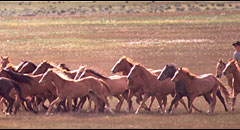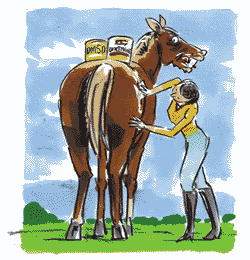 |
   |
|
|
|
You are here: Horses > Horse health > DMSO Equine Treatment |
Information on Dimethyl Sulfoxide (DMSO) Treatments for Horses
Dimethyl-Sulfoxide, or DMSO for short, is a substance that
is well known in veterinary circles. First and foremost it
is much appreciated for its superior ability to calm
swellings, relieve inflammation, and even help when spinal
and head trauma are involved, simply because DMSO penetrates
the animal’s skin quickly and in sufficient amounts to
assist in the healing. Horse owners swear by it to treat
founder and to reduce arthritic symptoms in their animals. |
|
|
Yet at the same time the use of this substance is dreaded
because of its rather pungent stench. Humans who use DMSO
are actually able to taste the substance in their mouths and
it is reportedly quite unappetizing. The use on a horse –
which has a much larger surface than a human – will cause
the smell of the substance to quickly and thoroughly
permeate the entire area where the horse is being kept. Stench notwithstanding, veterinarians recognize that DMSO
is a most valuable substance especially since it not |
 only
penetrates the skin quickly, but also takes along with it
other substances, such as antibiotics and anti-inflammatories.
What makes this drug so effective is the fact that it traps
free radicals within the animal’s organism. These free
radicals are found when tissue is damaged or deteriorating
and in turn they harm other tissues and make injuries worse
and significantly slow down the healing process. DMSO
significantly reduces the quantity of free radicals in
addition to producing sulfur which is known to be an
essential component in the production of the cells that make
up tissues. only
penetrates the skin quickly, but also takes along with it
other substances, such as antibiotics and anti-inflammatories.
What makes this drug so effective is the fact that it traps
free radicals within the animal’s organism. These free
radicals are found when tissue is damaged or deteriorating
and in turn they harm other tissues and make injuries worse
and significantly slow down the healing process. DMSO
significantly reduces the quantity of free radicals in
addition to producing sulfur which is known to be an
essential component in the production of the cells that make
up tissues.
Since 1970 this substance has been approved for use in
animals, yet with any drug that so easily penetrates the
skin, there are some warnings and dangers to consider. First
and foremost is the fact that DMSO is non-toxic in and of
itself, but may become dangerous when it is mixed with other
substances, especially when the mixing is unintentional and
dangerous materials are introduced to the body because of
the skin penetrating properties this drug has. Birth defects
have been cited as one side effect, and several shows have
banned the use of DMSO because it in conjunction with anti-inflammatories
was found to be performance enhancing. So be sure to always
wear thick rubber gloves when using DMSO on your horses.
Secondly, not all horses respond well to DMSO. As a matter
of fact, some animals will experience some skin irritation
as evidenced by dry and flaky skin in the treated area. If
your horse falls into this category, it is imperative to
stop treatment immediately and remove any residue left on
the skin with a mild soap. Fortunately, this is a very rare
occurrence. Another question on many a veterinarian’s mind
is the long term usage of this substance as this has not yet
been studied thoroughly.
Most often when sensitivities are experienced it may be
traced back to human error. For example, if DMSO is used
inexpertly and applied at the first sign of any injury, the
heating action of the substances causes increased blood flow
to the affected area and increases the swelling. The proper
treatment for very recent injuries is the exact opposite,
namely an application of cold packs to the affected area to
reduce swelling. In addition to the foregoing, DMSO is a
known irritant if applied to an open wound. Once again the
first treatment involves cold, not heat.
The proper application of DMSO may be in conjunction with
anti-inflammatories in order to curtail the swelling of
bones, and to relieve soreness of ligaments and muscles
tissue. If the injury runs deep, an intravenous mixture may
introduced to either alleviate inflammation or – if combined
with antibiotics – to gain the upper hand on a deep
infection.
Another substance that is closely related to DMSO is
methylsulfonylmethane or MSM for short. This drug is edible
and while less effective than DMSO it still packs a powerful
punch when it comes to alleviating pain and reducing
inflammations. This substance may be added to a horse’s feed
yet it still lacks FDA approval and as such many horse
owners are reluctant to employ it.

|
Read the next horse health tips article on Essential Minerals Horses Need. |
|
|
|
|
 |
|
|
|
|
|
Horse Education
|
|
|
|
|
Horse Information Topics
|
|
|
|
|
|
|
|
Horse Business Owners
|
| |
Advertise with Us
Have your horse products or services exposed to over 27,000 of our monthly visitors.
|
|
|
|
|
|